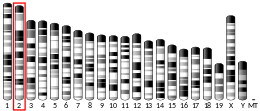가려움증
ITCHITCH는 HEC 도메인 E3 유비퀴틴 연결효소이며, 비아구티-치사성 18H(일명 가려움증) [5][6]생쥐에서 감소됩니다.가려운 쥐는 생후 림프세포와 조혈세포의 과형성, 위와 폐의 [7][8]염증을 포함한 심각한 면역 표현형을 발달시킨다.인간의 가려움증은 신체 성장, 두개골 안면 형태학 결함, 근육 발달 결함, 면역 체계 기능 이상을 [9]일으킨다.ITCH는 C2 도메인, 프롤린이 풍부한 영역, WW 도메인, HEC 도메인 및 인산화 및 유비쿼티화된 [10]여러 아미노산을 포함합니다.
인산화 조절
ITCH는 MAPK8에 [11]의해 규제됩니다.MAPK8은 ITCH의 MAPK8 의존적 인산화와 그에 따른 ITCH의 배향 변화에 의해 JUNB 단백질의 회전을 조절한다.이 메커니즘은 직접 인산화로 인해 Jun 패밀리 전사 인자가 직접 활성화되는 것과는 별개이다.ITCH는 그 성분의 직접 단백질 인산화로 유비쿼티화 기계의 규제에 대한 우리의 이해를 위한 패러다임으로 작용한다.중요한 것은 이 조절 과정이 JUNB 수치와 Interleukin 4 [12]전사를 음의 조절함으로써 Th2 사이토카인 분비물의 균형을 조절하는 것이다.
인터랙션 파트너
가려움증은 다음을 포함한 많은 [13]단백질과 상호작용하는 것으로 나타났다.
- CXCR4,[14]
- c-jun,[15]
- MAP2K4,[16]
- MAP3K1,[17]
- MAP3K7,[18]
- MAPK8,[19]
- N4BP1,[20]
- NOTCH [21]1,
- TP63 [22]및
- TP73.[23]
레퍼런스
- ^ a b c GRCh38: 앙상블 릴리즈 89: ENSG000078747 - 앙상블, 2017년 5월
- ^ a b c GRCm38: 앙상블 릴리즈 89: ENSMUSG000027598 - 앙상블, 2017년 5월
- ^ "Human PubMed Reference:". National Center for Biotechnology Information, U.S. National Library of Medicine.
- ^ "Mouse PubMed Reference:". National Center for Biotechnology Information, U.S. National Library of Medicine.
- ^ Perry WL, Hustad CM, Swing DA, O'Sullivan TN, Jenkins NA, Copeland NG (February 1998). "The itchy locus encodes a novel ubiquitin protein ligase that is disrupted in a18H mice". Nature Genetics. 18 (2): 143–146. doi:10.1038/ng0298-143. PMID 9462742. S2CID 9438916.
- ^ "Q96J02 SWISS-MODEL Repository".
- ^ Melino G, Gallagher E, Aqeilan RI, Knight R, Peschiaroli A, Rossi M, et al. (July 2008). "Itch: a HECT-type E3 ligase regulating immunity, skin and cancer". Cell Death and Differentiation. 15 (7): 1103–1112. doi:10.1038/cdd.2008.60. PMID 18552861. S2CID 2626150.
- ^ Aki D, Zhang W, Liu YC (July 2015). "The E3 ligase Itch in immune regulation and beyond". Immunological Reviews. 266 (1): 6–26. doi:10.1111/imr.12301. PMID 26085204. S2CID 42110767.
- ^ Lohr NJ, Molleston JP, Strauss KA, Torres-Martinez W, Sherman EA, Squires RH, et al. (March 2010). "Human ITCH E3 ubiquitin ligase deficiency causes syndromic multisystem autoimmune disease". American Journal of Human Genetics. 86 (3): 447–453. doi:10.1016/j.ajhg.2010.01.028. PMC 2833372. PMID 20170897.
- ^ "ITCH (human)". www.phosphosite.org. Retrieved 2020-10-27.
- ^ Karin M, Gallagher E (2005). "From JNK to pay dirt: jun kinases, their biochemistry, physiology and clinical importance". IUBMB Life. 57 (4–5): 283–295. doi:10.1080/15216540500097111. PMID 16036612. S2CID 25508987.
- ^ Gao M, Karin M (September 2005). "Regulating the regulators: control of protein ubiquitination and ubiquitin-like modifications by extracellular stimuli". Molecular Cell. 19 (5): 581–593. doi:10.1016/j.molcel.2005.08.017. PMID 16137616.
- ^ "ITCH itchy E3 ubiquitin protein ligase [Homo sapiens (human)] - Gene - NCBI". www.ncbi.nlm.nih.gov. Retrieved 2021-12-29.
- ^ Bhandari D, Robia SL, Marchese A (March 2009). "The E3 ubiquitin ligase atrophin interacting protein 4 binds directly to the chemokine receptor CXCR4 via a novel WW domain-mediated interaction". Molecular Biology of the Cell. 20 (5): 1324–1339. doi:10.1091/mbc.e08-03-0308. PMC 2649280. PMID 19116316.
- ^ Fang D, Kerppola TK (October 2004). "Ubiquitin-mediated fluorescence complementation reveals that Jun ubiquitinated by Itch/AIP4 is localized to lysosomes". Proceedings of the National Academy of Sciences of the United States of America. 101 (41): 14782–14787. doi:10.1073/pnas.0404445101. PMC 522008. PMID 15469925.
- ^ Ahn YH, Kurie JM (October 2009). "MKK4/SEK1 is negatively regulated through a feedback loop involving the E3 ubiquitin ligase itch". The Journal of Biological Chemistry. 284 (43): 29399–29404. doi:10.1074/jbc.M109.044958. PMC 2785572. PMID 19737936.
- ^ Enzler T, Chang X, Facchinetti V, Melino G, Karin M, Su B, Gallagher E (September 2009). "MEKK1 binds HECT E3 ligase Itch by its amino-terminal RING motif to regulate Th2 cytokine gene expression". Journal of Immunology. 183 (6): 3831–3838. doi:10.4049/jimmunol.0803412. PMID 19710465.
- ^ Kathania M, Zeng M, Yadav VN, Moghaddam SJ, Yang B, Venuprasad K (March 2015). "Ndfip1 regulates itch ligase activity and airway inflammation via UbcH7". Journal of Immunology. 194 (5): 2160–2167. doi:10.4049/jimmunol.1402742. PMID 25632008.
- ^ Gallagher E, Gao M, Liu YC, Karin M (February 2006). "Activation of the E3 ubiquitin ligase Itch through a phosphorylation-induced conformational change". Proceedings of the National Academy of Sciences of the United States of America. 103 (6): 1717–1722. doi:10.1073/pnas.0510664103. PMC 1413664. PMID 16446428.
- ^ Oberst A, Malatesta M, Aqeilan RI, Rossi M, Salomoni P, Murillas R, et al. (July 2007). "The Nedd4-binding partner 1 (N4BP1) protein is an inhibitor of the E3 ligase Itch". Proceedings of the National Academy of Sciences of the United States of America. 104 (27): 11280–11285. doi:10.1073/pnas.0701773104. PMC 2040890. PMID 17592138.
- ^ Puca L, Chastagner P, Meas-Yedid V, Israël A, Brou C (October 2013). "Α-arrestin 1 (ARRDC1) and β-arrestins cooperate to mediate Notch degradation in mammals". Journal of Cell Science. 126 (Pt 19): 4457–4468. doi:10.1242/jcs.130500. PMID 23886940.
- ^ Rossi M, Aqeilan RI, Neale M, Candi E, Salomoni P, Knight RA, et al. (August 2006). "The E3 ubiquitin ligase Itch controls the protein stability of p63". Proceedings of the National Academy of Sciences of the United States of America. 103 (34): 12753–12758. doi:10.1073/pnas.0603449103. PMC 1550770. PMID 16908849.
- ^ Rossi M, De Laurenzi V, Munarriz E, Green DR, Liu YC, Vousden KH, et al. (February 2005). "The ubiquitin-protein ligase Itch regulates p73 stability". The EMBO Journal. 24 (4): 836–848. doi:10.1038/sj.emboj.7600444. PMC 549609. PMID 15678106.







